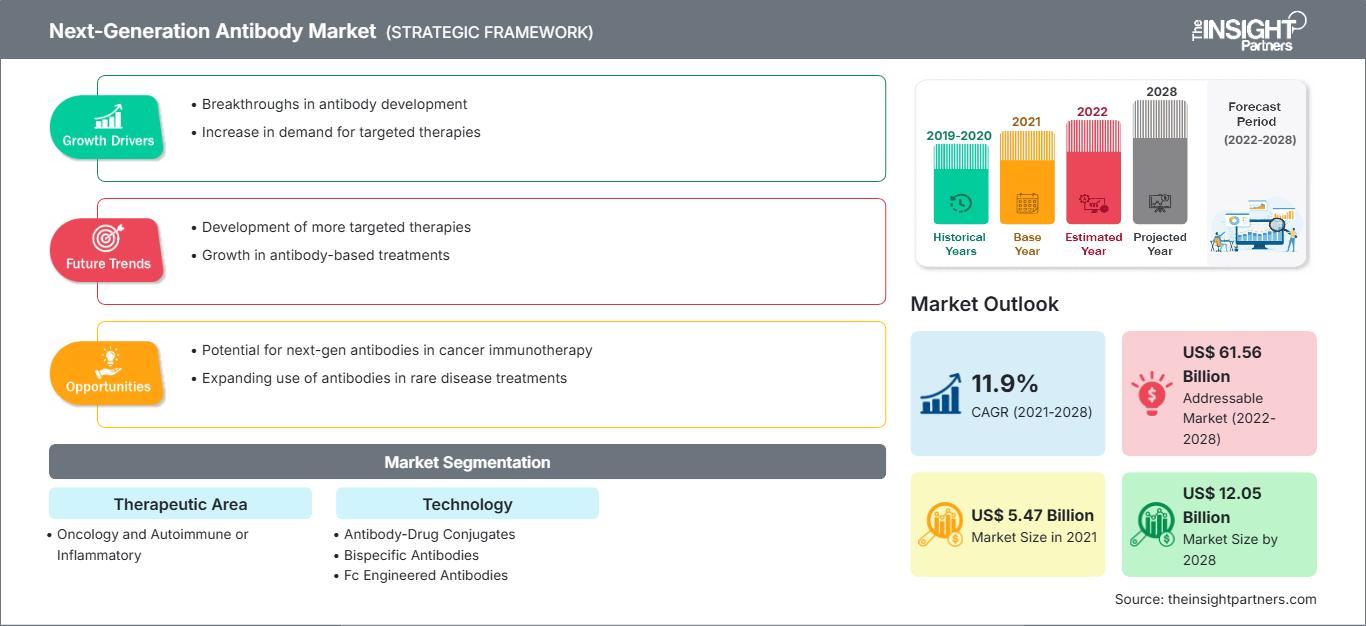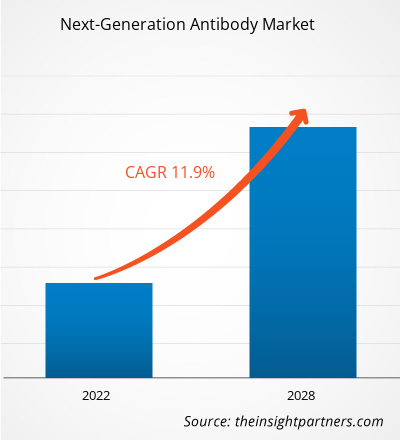Der Markt für Antikörper der nächsten Generation soll von 5.468,41 Millionen US-Dollar im Jahr 2021 auf 12.050,13 Millionen US-Dollar im Jahr 2028 anwachsen; von 2021 bis 2028 wird ein CAGR-Wachstum von 11,9 % erwartet.
Antikörper der nächsten Generation sind spezifischer und oft wirksamer als herkömmliche monoklonale Antikörper. Strategien für Antikörper der nächsten Generation sind erforderlich, um ein nützliches Therapeutikum zu entwickeln, das Antikörper, Nutzlast, Linker und Konjugationsmethode kombiniert und gleichzeitig Stabilität, zielgerichtete Verabreichung und begrenzte Off-Target-Effekte gewährleistet.
Der Bericht bietet Einblicke und eine eingehende Analyse des Marktes für Antikörper der nächsten Generation und hebt verschiedene Parameter wie Markttrends, technologische Fortschritte, Marktdynamik und eine Analyse der Wettbewerbslandschaft führender Marktteilnehmer weltweit hervor. Er berücksichtigt auch die Auswirkungen der COVID-19-Pandemie auf den Markt in allen Regionen. Die Pandemie hat die sozioökonomischen Bedingungen in verschiedenen Ländern weltweit gestört. Die USA sind derzeit das am stärksten vom COVID-19-Ausbruch betroffene Land weltweit und weisen laut aktuellen WHO-Statistiken die höchste Zahl an bestätigten Fällen und Todesfällen auf. Die hohe Zahl der COVID-19-Fälle hat sich negativ auf die Weltwirtschaft ausgewirkt. Die allgemeine Geschäftstätigkeit und das Wachstum verschiedener Branchen sind weltweit zurückgegangen.
Passen Sie diesen Bericht Ihren Anforderungen an
Sie erhalten kostenlos Anpassungen an jedem Bericht, einschließlich Teilen dieses Berichts oder einer Analyse auf Länderebene, eines Excel-Datenpakets sowie tolle Angebote und Rabatte für Start-ups und Universitäten.
Markt für Antikörper der nächsten Generation: Strategische Einblicke

-
Holen Sie sich die wichtigsten Markttrends aus diesem Bericht.Dieses KOSTENLOSE Beispiel umfasst Datenanalysen, die von Markttrends bis hin zu Schätzungen und Prognosen reichen.
Der COVID-19-Ausbruch hat die Gesundheitsinfrastruktur in den USA, Kanada und Mexiko enorm belastet. Darüber hinaus arbeiten die meisten Pharma- und Biotechnologieunternehmen sowie Forschungsinstitute an der Entwicklung von Impfstoffen und Medikamenten gegen COVID-19. Sowohl etablierte Pharmaunternehmen als auch kleine Start-ups arbeiten an der Weiterentwicklung von Behandlungen und Impfstoffen gegen die durch das neuartige Coronavirus verursachte Infektion. Daher gelten impfstoffbezogene Forschungsaktivitäten in Pharma- und Biotechnologieunternehmen, Forschungszentren und Lehrforschungsinstituten als unverzichtbar und sind in Betrieb und Produktion weitgehend unbeeinträchtigt. Aufgrund der zunehmenden Forschungsaktivitäten wird jedoch erwartet, dass sowohl die Verfügbarkeit von Finanzmitteln für Analysen als auch der Bedarf an Antikörpern, einschließlich Antikörpern der nächsten Generation, steigen werden. Darüber hinaus beschäftigen sich im Zuge des COVID-19-Ausbruchs weltweit viele Forscher mit der Virusforschung zu SARS-CoV-2, dem Virus, das COVID-19 verursacht. Sowohl für Impfstoffe als auch für Therapeutika werden die erzeugten Antikörper auf ihre funktionelle Effizienz hin untersucht, um dem Zielvirus entgegenzuwirken. Daher wird erwartet, dass die COVID-19-Pandemie den Markt für Antikörper der nächsten Generation in den kommenden Jahren positiv beeinflussen wird.
Nach Regionen ist der Markt für Antikörper der nächsten Generation in Nordamerika, Europa, Asien-Pazifik, den Nahen Osten und Afrika sowie Süd- und Mittelamerika unterteilt.
Markteinblicke
Wachsende Nachfrage nach Antikörpertherapeutika der nächsten Generation treibt den Markt für Antikörper der nächsten Generation voran
Die zunehmenden Entwicklungen in der Biotechnologie haben zu einer zunehmenden Akzeptanz von Antikörpertherapeutika der nächsten Generation geführt, was ihren Einsatz in der Behandlung von Autoimmun-, Entzündungs- und chronischen Erkrankungen vorantreibt. Antikörperbehandlungen der nächsten Generation sind das Ergebnis der Anwendung hochentwickelter Technologien in der Antikörpertherapeutik, wie Antikörper-Wirkstoff-Konjugaten (ADCs), glykoengineerten Antikörpern und spezifischen Antikörpern (BsAbs). Daher werden Einsatzmöglichkeiten von Antikörpern der nächsten Generation zur Behandlung verschiedener chronischer Krankheiten wie Krebs, HIV, Infektionskrankheiten usw. umfassend erforscht. Die steigende Nachfrage nach diesen Antikörpern hat zu einer raschen Zunahme der Zulassungen von ADCs und anderen Antikörpertherapeutika der nächsten Generation geführt. So gab Takeda Pharmaceutical Company Limited im Mai 2020 die FDA-Zulassung von ALUNBRIG (Brigatinib) für erwachsene Patienten mit Anaplastische-Lymphomkinase-positivem (ALK+) metastasiertem nicht-kleinzelligem Lungenkrebs (NSCLC) bekannt, der durch einen von der FDA zugelassenen Test festgestellt wurde. Mit der Zulassung wurde die aktuelle Indikation von ALUNBRIG auf die Erstlinientherapie ausgeweitet. ALUNBRIG ist ein Tyrosinkinase-Inhibitor (TKI) der nächsten Generation, der auf molekulare ALK-Anomalien abzielt. Ebenso gab Genentech 2019 die beschleunigte FDA-Zulassung von Polatuzumab Vedotin-Piiq bekannt, einem CD79b-gerichteten Antikörper-Wirkstoff-Konjugat, das in Kombination mit Bendamustin und einem Rituximab-Produkt für erwachsene Patienten mit rezidiviertem oder refraktärem diffusem großzelligem B-Zell-Lymphom angezeigt ist.
Daher wird erwartet, dass der Markt für Antikörper der nächsten Generation im Prognosezeitraum aufgrund der steigenden Zulassungen für klinische Studien und der hohen Akzeptanz von Antikörpertherapeutika der nächsten Generation zur Behandlung verschiedener Krankheiten schnell wachsen wird.
Erkenntnisse nach Therapiebereichen
Basierend auf dem Therapiebereich ist der Markt für Antikörper der nächsten Generation in Onkologie und Autoimmun- bzw. Entzündungskrankheiten unterteilt. Das Onkologiesegment hatte einen größeren Marktanteil.
Technologiebasierte Erkenntnisse
Der Markt für Antikörper der nächsten Generation ist technologisch in Antikörper-Wirkstoff-Konjugate, bispezifische Antikörper, Fc-modifizierte Antikörper, Antikörperfragmente und antikörperähnliche Proteine sowie biosimilare Antikörperprodukte unterteilt. Das Segment der Antikörper-Wirkstoff-Konjugate hatte 2021 den größten Marktanteil und wird im Prognosezeitraum voraussichtlich die höchste durchschnittliche jährliche Wachstumsrate (CAGR) von 12,1 % verzeichnen.
Die Akteure auf dem Markt für Antikörper der nächsten Generation verfolgen verschiedene organische Strategien, wie z. B. Produkteinführungen und -erweiterungen, um ihre Präsenz und ihr Produktportfolio weltweit zu erweitern und die wachsende Nachfrage zu decken.
Antikörper der nächsten Generation
Regionale Einblicke in den Markt für Antikörper der nächsten Generation
Die Analysten von The Insight Partners haben die regionalen Trends und Faktoren, die den Markt für Antikörper der nächsten Generation im Prognosezeitraum beeinflussen, ausführlich erläutert. In diesem Abschnitt werden auch die Marktsegmente und die geografische Lage für Antikörper der nächsten Generation in Nordamerika, Europa, dem asiatisch-pazifischen Raum, dem Nahen Osten und Afrika sowie Süd- und Mittelamerika erörtert.
Umfang des Marktberichts zu Antikörpern der nächsten Generation
| Berichtsattribut | Einzelheiten |
|---|---|
| Marktgröße in 2021 | US$ 5.47 Billion |
| Marktgröße nach 2028 | US$ 12.05 Billion |
| Globale CAGR (2021 - 2028) | 11.9% |
| Historische Daten | 2019-2020 |
| Prognosezeitraum | 2022-2028 |
| Abgedeckte Segmente |
By Therapiebereich
|
| Abgedeckte Regionen und Länder |
Nordamerika
|
| Marktführer und wichtige Unternehmensprofile |
|
Dichte der Marktakteure für Antikörper der nächsten Generation: Verständnis ihrer Auswirkungen auf die Geschäftsdynamik
Der Markt für Antikörper der nächsten Generation wächst rasant. Die steigende Nachfrage der Endverbraucher ist auf Faktoren wie veränderte Verbraucherpräferenzen, technologische Fortschritte und ein stärkeres Bewusstsein für die Produktvorteile zurückzuführen. Mit der steigenden Nachfrage erweitern Unternehmen ihr Angebot, entwickeln Innovationen, um den Bedürfnissen der Verbraucher gerecht zu werden, und nutzen neue Trends, was das Marktwachstum weiter ankurbelt.

- Holen Sie sich die Markt für Antikörper der nächsten Generation Übersicht der wichtigsten Akteure
Firmenprofile
- F. HOFFMANN-LA ROCHE LTD.
- Kyowa Kirin Co., Ltd.
- Seagen Inc.
- ImmunoGen, Inc.
- Takeda Pharmaceutical Company Limited
- Amgen Inc.
- Pfizer Inc.
- Catalent Inc
- AstraZeneca
- Xencor
- Historische Analyse (2 Jahre), Basisjahr, Prognose (7 Jahre) mit CAGR
- PEST- und SWOT-Analyse
- Marktgröße Wert/Volumen – Global, Regional, Land
- Branchen- und Wettbewerbslandschaft
- Excel-Datensatz
Aktuelle Berichte
Erfahrungsberichte
Grund zum Kauf
- Fundierte Entscheidungsfindung
- Marktdynamik verstehen
- Wettbewerbsanalyse
- Kundeneinblicke
- Marktprognosen
- Risikominimierung
- Strategische Planung
- Investitionsbegründung
- Identifizierung neuer Märkte
- Verbesserung von Marketingstrategien
- Steigerung der Betriebseffizienz
- Anpassung an regulatorische Trends






















 Kostenlose Probe anfordern für - Markt für Antikörper der nächsten Generation
Kostenlose Probe anfordern für - Markt für Antikörper der nächsten Generation